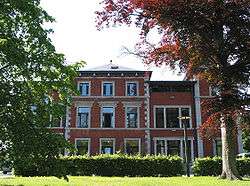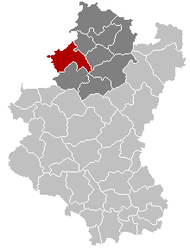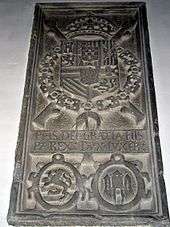Marche-en-Famenne
Marche-en-Famenne (French pronunciation: [maʁʃ ɑ̃ famɛn]; Walloon: Måtche-el-Fåmene, pronounced [mɑːtʃ ɛl fɑːmɛn]) is a Walloon municipality located in the Belgian province of Luxembourg. It is the unofficial capital of the Famenne region, sandwiched between the Condroz, former land of the Condrusi, to the north and the Ardennes to the south.
Marche-en-Famenne | |
|---|---|
 City hall | |
 Coat of arms | |
 Marche-en-Famenne Location in Belgium
Location of Marche-en-Famenne in Luxembourg province  | |
| Coordinates: 50°13′N 05°20′E | |
| Country | Belgium |
| Community | French Community |
| Region | Wallonia |
| Province | Luxembourg |
| Arrondissement | Marche-en-Famenne |
| Government | |
| • Mayor | André Bouchat (CDH) |
| • Governing party/ies | CDH, MR |
| Area | |
| • Total | 121.40 km2 (46.87 sq mi) |
| Population (2018-01-01)[1] | |
| • Total | 17,455 |
| • Density | 140/km2 (370/sq mi) |
| Postal codes | 6900 |
| Area codes | 084 |
| Website | www |
The Marche-en-Famenne municipality includes the former municipalities (sections) of Aye, Grimbiémont, Hargimont, Hollogne, Humain, Lignières, Marloie, On, Roy, Verdenne, and Waha.
History
Middle Ages
In the early Middle Ages, Marche was just a little hamlet on the Marchette brook, one of the dependencies of the nearby Abbey of Stavelot. In the 12th century, this territory was made part of the County of La Roche. It was ideally located, on the main road between Namur and Luxembourg, and quickly evolved into a town, which obtained its charter in the 13th century. At the end of the century, in true medieval fashion, it acquired a complete system of defensive walls, with two gates, a series of watchtowers, and a keep. The market place and religious organizations, such as the Carmes convent founded in 1473, could thrive inside the closed city.

After 1500
When in 1555 Philip II of Spain, son of Charles V, inherited his father's empire, the freedoms of Spain’s Seventeen Provinces to the north were reduced considerably, giving rise to the Eighty Years' War. In the aftermath of the Pacification of Ghent, Don John of Austria, Philip II’s half brother, granted the Perpetual Edict, which was signed in the city in February 1577. The edict allowed for the departure of the Spanish troops and recognized most of the city’s freedoms, with the notable exception of religion. The war started again and Don John died a year later near Namur.
The castle and defensive walls were dismantled at the end of the 17th century on the orders of Louis XIV. A century later, the French Revolutionary troops entered the city and closed the convent. Today, with its schools, light industries, military complex, and tourist attractions, Marche is a vibrant regional centre.
Sights
- The city centre includes a few interesting buildings, such as the St Remacle church and the old Carmes convent.
- The city is the home of several museums, including a lace museum, which is housed in one of the last remnants of the city’s medieval walls and commemorates the hundreds of lace workers that lived in the Marche area in the 18th century.
- The Famenne museum gives a good overview of the region’s art and history.
 Church of St Remacle
Church of St Remacle The law courts
The law courts The Jadot park
The Jadot park
Festivities
- The Grosse Biesse (Great Beast) carnival takes place every year in February. It features the beast, as well as the city's mascot Gugusse, traditional giants, and several other groups of joyful characters.
- A folkloric group called La Plovinette (Fine Drizzle) specializes in traditional Walloon dancing.
Notable people from Marche-en-Famenne
- Pierre Bailly, Belgian comics artist
- Jacques Beurlet, football player
- André Bouchat, politician
- Arnaud Brihay, Belgian artist
- Dany, Belgian comics artist
- Frans Depooter, Belgian painter
- Willy Deweert, Belgian writer
- Benoît Feroumont, Belgian comics artist
- Charles Hanin, politician
- Jean Jadot, Belgian engineer
- Joseph Nusbaum, Belgian architect
- Brigitte Olivier, Belgian judoka
- Phil, Belgian comics artist
- Luc Templier, writer
References
- "Wettelijke Bevolking per gemeente op 1 januari 2018". Statbel. Retrieved 9 March 2019.
Further reading
- Makos, Adam (2019). Spearhead (1st ed.). New York: Ballantine Books. pp. 69, 70, 77, 85, 88. ISBN 9780804176729. LCCN 2018039460. OL 27342118M.
External links
| Wikimedia Commons has media related to Marche-en-Famenne. |
